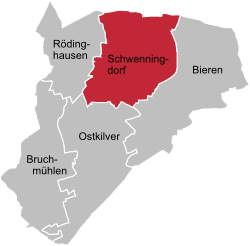Klosterbach (Große Aue)
North Rhine-Westphalia river stubsRivers of GermanyRivers of North Rhine-WestphaliaTributaries of the Große Aue

The Klosterbach is a right-hand tributary of the Große Aue, which is known as the Neuer Mühlenbach at the point where they join, in north Germany. The Klosterbach lies entirely within the parish of Rödinghausen in the district of Herford, North Rhine-Westphalia. The Klosterbach emerges north of Bieren near the Donoer Berg on the southern edge of the Wiehen Hills at a height of 152 m above sea level (NN). The stream discharges into the Große Aue after 1.6 kilometres at a height of 94 m above NN at river kilometre 82.9 on the Aue. The Klosterbach descends a height of 58 metres.
Excerpt from the Wikipedia article Klosterbach (Große Aue) (License: CC BY-SA 3.0, Authors, Images).Klosterbach (Große Aue)
Mühlenkamp, Rödinghausen Bieren
Geographical coordinates (GPS) Address Nearby Places Show on map
Geographical coordinates (GPS)
| Latitude | Longitude |
|---|---|
| N 52.251666666667 ° | E 8.5288888888889 ° |
Address
Mühlenkamp
Mühlenkamp
32289 Rödinghausen, Bieren
North Rhine-Westphalia, Germany
Open on Google Maps










